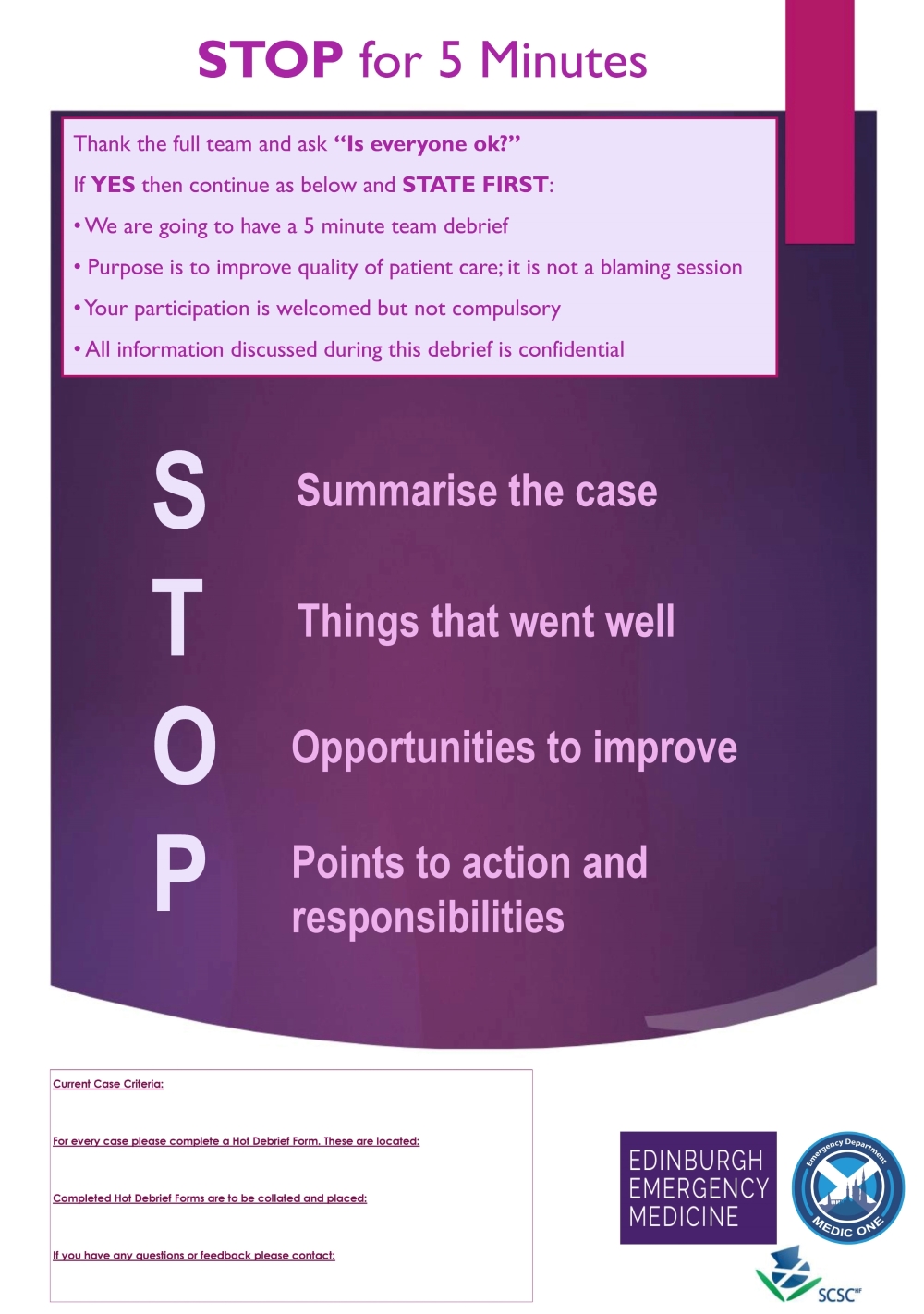When it all goes wrong: the importance of debrief
This is article eight in an RCVS Knowledge series of features on patient safety, clinical human factors, and the principles and associated themes of Quality Improvement (QI).
“Stop! Ok thanks everyone, it’s time to stop. Time of death 3:21pm”
As the room ground to a halt and silence and sadness filled the air, Lewis slid down the wall to his knees, a million questions racing around his head, “why, why, why?” as a lump formed in his throat, he watched Isabelle, (the nurse who had been caring for Lucky and raised the alarm) stroking the dogs head, a tear rolling down her cheek as she whispered, “Sleep tight my love”.
This was the worst part of their job; how could they just continue with their day? Was it their fault? What happened? Why was the resuscitation attempt not successful?
Looking up again Isabelle suggests, “Stop for 5?” Lewis nodded getting up off the floor, “I will put the kettle on.”
Stop5 or ‘Stop for 5 Minutes’ is a hot debrief framework that can be led by any member of the resuscitation team. The purpose of this confidential, blame free, team debrief is to improve patient care and to deliver timely support to team members after difficult or distressing clinical cases1.
Download the 'stop for five minutes' poster.
By stopping for 5 minutes, checking everyone is ok, summarising the case and the things that well, and identifying the opportunities for learning and improvement it is hoped that those involved can begin to understand what happened and why. Thus, reducing the likelihood of psychological harm, moral injury, or becoming second victims.
Without adequate debrief, team members may feel emotional trauma by adverse events like the one described above and experience a multitude of symptoms that can last from days to years. Damage to their physical and emotional health; and deteriorating individual and team performance can ultimately compromise patient safety. An understanding of the recovery process can be useful for monitoring victims and connecting them with appropriate support resources.
Throughout second victim recovery, it is essential that a culture of teamwork is embraced, the victim may need support from colleagues and friends to process the incident and enable them to move on. When second victims reach stage five, sometimes support from friends or colleagues falls short, so it’s important to ensure adequate signposting to support organisations such as VetLife is made. Ultimately there are three outcomes when moving on: dropping out, surviving, or thriving. Those who thrive were identified as participants who had made something good come out of the experience2.
Debriefs are known to improve team and individual performance by 20 – 25%3 and help prevent further untoward events (RCN, 2019). Other potential benefits of debriefs are improved staff moral; team cohesion; improved care for future patients and promoting a culture of learning, patient safety and quality improvement1.
Whilst a hot debrief is a short process that occurs immediately after the incident a cold debrief takes place days or weeks after the event has occurred and may take the form of a significant event audit (SEA) or morbidity and mortality meeting (M&M). Cold debriefs are also powerful tools to educate staff and improve patient safety and care and have been taking place in human healthcare for over a decade. M&M’s now form part of the Royal College of Veterinary Surgeons Practice Standards Scheme.
As research4 highlights, the increasing evidence of mental strain and suicide risk within the veterinary profession, and Vetlife report a 25% increase in calls between 2019 and 2020 it is imperative that everything possible is done to improve the culture of veterinary practice. By imbedding debrief tools such as STOP5 within daily practice to ensure that team members are supported in the aftermath of critical events, safety culture is improved, and job satisfaction heightened.
Unfortunately, we can’t always prevent things from going wrong, so remember to be kind to yourself and others. “Stop beating yourself up about things from the past. Instead of slapping your forehead and asking, ‘what was I thinking?’. Breathe and ask a kinder question ‘what was I learning?’5.
Download the 'second victim recovery' graphic.
Checklist: What can you do next?
- Use a hot debrief framework, developed by Edinburgh Emergency Medicine, for veterinary practices in collaboration with RCVS Knowledge.
- Read RCVS Knowledge’s Rolling take 5- Questions to discuss as a team to help improve communication between shift teams, to identify areas for improvement, to identify processes that have worked well, and flag up required support for the team.
- Read Mark Turner's blog, Improving Patient Safety: new horizons, new perspectives, where he talks about the 'Stress Management Model,' which helps to highlight an integrated approach to mental health at work.
- Visit the Vetlife website, a charity the provides free support to veterinary professionals in the UK.
- Listen to Margaret Mary Devaney and Anita Malana’s podcast on QI, Safety Systems, and Just Culture in the NHS.
- Look at RCVS Knowledge’s free SEA tools and resources, including free CPD that will help you understand the processes you can put in place to help improve outcomes.
- Visit Second Victim Support to learn more about the stages that second victims experience.
References
1Walker, C.A. et al. (2020) STOP5: a hot debrief model for resuscitation cases in the emergency department. Clinical and Experimental Emergency Medicine, 7 (4), pp. 259-266 https://doi.org/10.15441/ceem.19.086
2Scott, S.D. et al. (2009) The natural history of recovery for the healthcare provider “second victim” after adverse patient events. BMJ Quality & Safety, 18 (5), pp. 325-330 http://dx.doi.org/10.1136/qshc.2009.032870
3Tannenbaum, S.I. and Cerasoli, C.P. (2013) Do team and individual debriefs enhance performance? A meta-analysis. Human Factors, 55 (1), pp. 231-45 https://doi.org/10.1177/0018720812448394
4Tomasi, S.E. et al. (2019) Suicide among veterinarians in the United States from 1979 through 2015. Journal of the American Veterinary Medical Association, 254 (1), pp. 104-112 https://doi.org/10.2460/javma.254.1.104
5Salmansohn, K. (2008) Bounce back! How to thrive in the face of adversity. New York: Workman
About the author
Helen is an RCVS Knowledge Champion for her role in the sustained training and use of a surgical safety checklist within the small animal theatre at the former Animal Health Trust.
In 2018, Helen began an MSc in Patient Safety and Clinical Human Factors at the University of Edinburgh. The programme supports healthcare professionals in using evidence-based tools and techniques to improve the reliability and safety of healthcare systems.
It includes how good teamwork influences patient outcomes, key concepts around learning from adverse events and teaching safety, understanding the specialty of clinical human factors, as well as the concept of implementing, observing, and measuring change, monitoring for safety, and it focuses on quality improvement research and methodologies.
May 2021